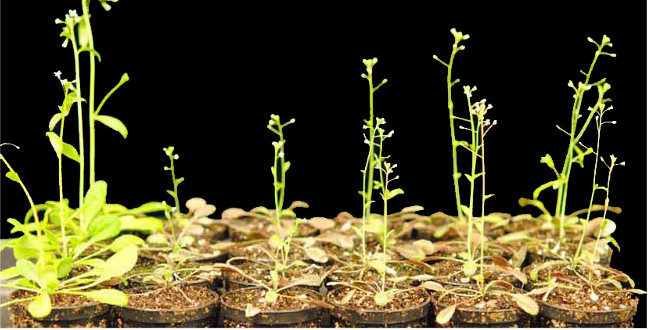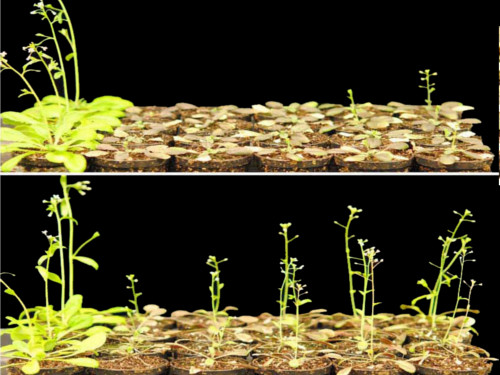Bioscience
Herbicide resistance: shedding light on the shikimate pathway
Resistance to a popular herbicide provides insight into the control of a key biosynthetic pathway.


Effect of glyphosate application at different times of day. Top: wild type plants; bottom, gre1 plants. Treatments, from left to right: control (no glyphosate applied), glyphosate treatment at 0500, 0900, 1300, 1700 and 2100
© Chris Gehring/The Plant Journal
Researchers have now linked light sensitivity to a certain metabolic pathway in hopes of understanding herbicide resistivity. One metabolic route of plants, known as the shikimate pathway, is a fundamental production line for secondary metabolites and essential amino acids and is disrupted by the herbicide glyphosate. Widespread glyphosate use has promoted the evolution of resistant weeds, mostly through causing mutations in the herbicide’s target enzyme, EPSPS.
Now, scientists from KAUST and Purdue University in the USA, have discovered a new mechanism of resistance based on light-receptive phytochromes, which reveals a light-dependent system of control over the shikimate pathway. This can explain temporal variations in glyphosate effectiveness and may contribute to enhanced production of useful plant metabolites.
Altanbadralt Sharkhuu and Chris Gehring, from KAUST’s Biological and Environmental Science and Engineering Division, introduced mutations in the model plant Arabidopsis by inserting small pieces of bacterial DNA into its genome. One mutant, gre1, showed glyphosate resistance. Further investigation showed that this resistance depends on light quality and intensity, and genetic analyses indicated that gre1 is deficient in phytochrome B (phyB).
PhyB is present in active and inactive forms dependent on the ratio of red to far-red light. In gre1 this response is impaired, causing over-production of the components of the shikimate pathway, including EPSPS, and therefore resistance to glyphosate. Evidence for this is that over-production of phyB causes glyphosate-hypersensitivity.
Gehring explains that “the key discovery is that phyB regulates the shikimate pathway, which is central to the biosynthesis of highly valuable secondary metabolites and aromatic amino acids.”
Two enzymes of the pathway contain molecular motifs associated with phytochrome interactions. Significantly, two further enzymes contain elements associated with circadian regulation. The KAUST team therefore looked for — and confirmed — circadian variation in the pathway, by quantifying gene expression throughout the day. They found that the shikimate pathway is regulated not just by phyB but by an integrated system including the innate circadian clock.
The team proposed that, while the clock maintains general control of the pathway, phyB can override this in response to changing environmental conditions.
The effectiveness of glyphosate is known to be affected by the time at which it is sprayed (see image). Variation in the shikimate pathway, under the control of the circadian clock, phyB and changing light quality, now explains why, and offers methods for best glyphosate use to reduce environmental impact.
“This opens the possibility to use light quality regimes to boost the production of specific metabolites,” adds Gehring. The team is currently testing this in green algae, which also use the shikimate pathway.
References
- Altanbadralt, S., Narasimhan, M.L., Merzaban, J.S., Bressan, R.A., Weller, S., et al. A red and far-red light receptor mutation confers resistance to the herbicide glyphosate. The Plant Journal 78, 916-926 (2014). | article
You might also like

Bioengineering
High value harvests from designer algae

Bioscience
Digging into the world of plant-growth-promoting microbes

Bioengineering
Stray DNA fragments challenge CRISPR precision

Bioscience
Unique microbiome discovered in mountain streams

Bioscience
How a multitasking protein keeps the body’s clock in sync

Bioscience
The theory of everything that wasn’t

Bioscience
Mangrove microbes to munch on plastic

Bioscience



